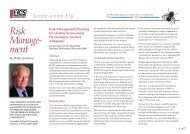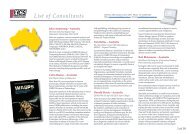Manual for Diagnosis of Screw-worm Fly - xcs consulting
Manual for Diagnosis of Screw-worm Fly - xcs consulting
Manual for Diagnosis of Screw-worm Fly - xcs consulting
Create successful ePaper yourself
Turn your PDF publications into a flip-book with our unique Google optimized e-Paper software.
A <strong>Manual</strong> <strong>for</strong> the <strong>Diagnosis</strong> <strong>of</strong> <strong>Screw</strong>-Worm <strong>Fly</strong><br />
Measure solids first and add liquids, adding dimethyl disulphide last. It is crucial that the<br />
correct chemicals be used, especially the n-isomers <strong>of</strong> butyric and valeric acids. Care must<br />
be taken when mixing and dispensing s<strong>worm</strong>lure which is very caustic, and has a long-lasting<br />
and unpleasant odour. Store in a refrigerator not used <strong>for</strong> foodstuffs.<br />
The traps are suspended by cords from trees or posts at a height <strong>of</strong> about 1.5m. For<br />
surveillance, maximising the opportunity <strong>for</strong> catching SWF is important and shady sites at<br />
the edge <strong>of</strong> wooded areas, near water sources or cattle camps are recommended. Close<br />
proximity to rubbish dumps or animal carcasses will result in large numbers <strong>of</strong> secondary<br />
blowflies on the traps and these sites should be avoided.<br />
Traps can be serviced at convenient intervals from daily to weekly. Up to 10 days exposure<br />
can be used but trapped flies deteriorate with time. In some locations, <strong>for</strong>aging stingless<br />
bees may remove the adhesive. When serviced, the aluminium plate is replaced and the<br />
s<strong>worm</strong>lure container replenished. When large numbers <strong>of</strong> traps are being serviced, trap<br />
plates can be stored in plywood boxes (35 x 60cm in cross section) <strong>of</strong> sufficient length to<br />
hold the number <strong>of</strong> (paired) plates required.<br />
Flies on the trap plate are removed with <strong>for</strong>ceps and placed on appropriately labelled (locality,<br />
trap number, date, etc.) cards or plastic petri dishes, using the residual adhesive to attach fly<br />
to card or dish. Cards or dishes can be stored in a freezer to await microscopical examination<br />
and identification.<br />
Larva <strong>of</strong> the New World screw-<strong>worm</strong> fly Cochlimyia hominivorax.<br />
Scanning electron microscope photograph by Colin Beaton<br />
56




